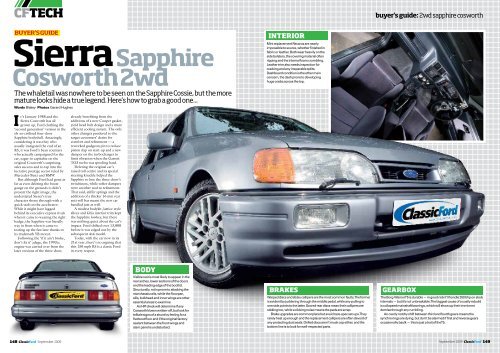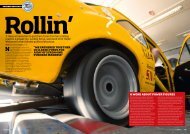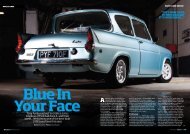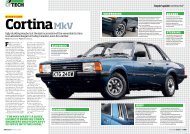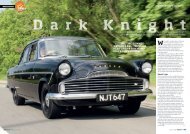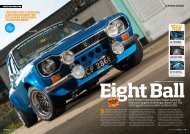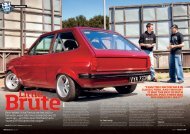Sierra Sapphire Cosworth 2wd - Classic Ford
Sierra Sapphire Cosworth 2wd - Classic Ford
Sierra Sapphire Cosworth 2wd - Classic Ford
- No tags were found...
Create successful ePaper yourself
Turn your PDF publications into a flip-book with our unique Google optimized e-Paper software.
cftechbuyer’s guide: <strong>2wd</strong> sapphire cosworthBUYER’S GUIDE<strong>Sierra</strong> <strong>Sapphire</strong><strong>Cosworth</strong> <strong>2wd</strong>The whaletail was nowhere to be seen on the <strong>Sapphire</strong> Cossie, but the moremature looks hide a true legend. Here’s how to grab a good one...Words Blakey Photos Gerard HughesIt’s January 1988 and the<strong>Sierra</strong> <strong>Cosworth</strong> has allgrown up, <strong>Ford</strong> clothing the‘second generation’ version in theoh-so-civilised four-door<strong>Sapphire</strong> bodyshell. Amazingly,considering it was they whousually instigated the end of anRS, it was <strong>Ford</strong>’s bean counterswho actually campaigned for thecar, eager to capitalise on theoriginal <strong>Cosworth</strong>’s surprisingsales success and to tap into thelucrative prestige sector ruled byMercedes-Benz and BMW.But although <strong>Ford</strong> had gone asfar as even deleting the boostgauge on the grounds it didn’tpresent the right image, theunderstated <strong>Sierra</strong>’s truecharacter shone through with aquick stab on the accelerator.While it might have laggedbehind its executive express rivalswhen it came to wearing the rightbadge, the <strong>Sapphire</strong> was literallyway in front when it came totearing up the fast lane thanks toits trademark YB motor.Following the ‘if it ain’t broke,don’t fix it’ adage, the 1993ccengine was carried over from thelater versions of the three-door,already benefiting from theadditions of a new Cooper gasket,yield head bolt design and a moreefficient cooling system. The onlyother changes pandered to thetarget customers’ desire forcomfort and refinement — areworked gudgeon pin to reducepiston slap on start-up and a newdamper on the turbocharger tolimit vibration when the GarrettTO3 turbo was spooling hard.Deleting the original car’sraised roll centre and its specialsteering knuckle helped the<strong>Sapphire</strong> to lose the three-door’stwitchiness, while softer damperswere another nod to refinement.That said, stiffer springs and theaddition of a thicker 16 mm rearanti-roll bar meant the new carhandled just as well.A modest bodykit, lattice-stylealloys and Ghia interior trim keptthe <strong>Sapphire</strong> lowkey, but therewas nothing quiet about the car’simpact. <strong>Ford</strong> shifted over 13,000before it was edged out by thesubsequent 4x4 model.Today, with the car now in its21st year, there’s no arguing thatthis 150 mph RS is a classic <strong>Ford</strong>in every respect.InteriorMint replacement Recaros are nearlyimpossible to source, whether finished infabric or leather. Both wear heavily on theside bolsters, the covering material oftenripping and the internal foam crumbling.Leather trim also needs inspection forcracking and any irreparable splits.Dashboard condition is the other mainconcern, the dash prone to developinghuge cracks across the top.BodyVisible rust is most likely to appear in therear arches, lower sections of the doorsand the leading edge of the bootlid.Structurally, rot is prone to attacking therear chassis rails, while the floorpan,sills, bulkhead and inner wings are otheressential areas to examine.An HPI check will determine if any<strong>Cosworth</strong>’s been written-off, but look fortelltale signs of a shunt by feeling for aflat boot floor and if the original factorysealant between the front wings andslam panel is undisturbed.BrakesWarped discs and sticky callipers are the most common faults. The formeris evident by juddering through the middle pedal, while any pulling toone side points to the latter. Scored rear discs mean their callipers aresticking too, while a clicking noise means the pads are scrap.Brake upgrades are commonplace but avoid race-spec set-ups. Theyrarely heat up enough and the replacement callipers are often devoid ofany protecting dust seals. Drilled discs aren’t much cop either, and thebottom line is to look for well-respected parts.GearboxThe Borg-Warner T5 is durable — in good nick it’ll handle 350 bhp on stockinternals — but it’s not unbreakable. The biggest cause of a costly rebuildis collapsed mainshaft bearings, which will show up their imminentdemise through any rumbling.An overly notchy shift between third and fourth gears means thesynchro rings are dying, but don’t be alarmed if first and reverse gearsoccasionally baulk — this is just a trait of the T5.148 September 2009September 2009 149
cftechbuyer’s guide: <strong>2wd</strong> sapphire cosworth“the understatedsapphire’s truecharacter shonethrough with a quickstab on the accelerator”SpecBody<strong>Sapphire</strong> four-door saloonin Ghia trim, colourcodedbodykitEngine<strong>Ford</strong> <strong>Cosworth</strong> YBB, 1993cc,four-cylinder, 204 bhp at 6000rpm, cast iron block,aluminium cylinder head, fourvalves per cylinders, twinoverhead camshafts, beltdrive, Weber-Marelli fuelinjection and management,Garrett T03 turbocharger withintercooler, max torque: 205 Ib.ft at 4500 rpmGearboxFive-speed Borg-WarnerT5SuspensionFront: Independent byMacPherson struts,coil springs, lower trackcontrol arms, anti-roll bar,telescopic dampersSteering &SuspensionA crashy, wallowy ride meansthe springs and dampers arepast it, while wandering steeringpoints to worn bushes. A saggystance is another indication oftired suspension and the carshould sit circa 0.75 inches higherat the back than at the front.Aftermarket suspension is rife.A modest drop of 25 mm isdeemed to be the most beneficialto handling and it’s essential thatany components are of areputable brand.electricsOld wiring and iffy contacts are themost common causes of anyelectrical faults, so thoroughlyinspect any underbonnet wiringfor heat damage. Aged securitydevices can also play havoc withthe loom and their operationneed to knowClubs & ForumsThe <strong>Ford</strong> RS Owners’ ClubPO Box 408, Grays,Essex, RM17 9ED.www.rsownersclub.co.ukPassion<strong>Ford</strong>www.passionford.com<strong>Ford</strong> <strong>Sierra</strong> Owners’ Clubwww.fordsierraclub.co.ukTurbosportwww.turbosport.co.ukSpecialistsBurton Power020 8518 9136www.burtonpower.comCollins Engineering01260 279604www.mongooseexhausts.comneeds double-checking. Naturally,ensure every factory switch andelectrical feature works, includingthe twin fans. These use theharness of a normal <strong>Sierra</strong> and theadded current draw often meltsthe wiring.Graham Goode Racing0116 244 0080www.grahamgoode.comNorth Yorks RS Spares01751 477766www.cosworthrsspares.co.ukInsuranceFully comprehensive insurancefor a <strong>Sierra</strong> <strong>Sapphire</strong> <strong>Cosworth</strong><strong>2wd</strong> valued at £5000 is £475 (with£500 excess) per year, based onan annual mileage of 5000 andinsured as a second car for a30-year-old with a CM2 postcode.Quote provided by <strong>Classic</strong> <strong>Ford</strong>Insurance, 0800 0276146, www.classicford insurance.co.uk.Values£2500-£3500MoT’d runners. Expect highmiles, scabby bodywork and theneed for much TLC.£3500-£4500Tidy cars that might need a littlework but are capable of regular,reliable use.£4500-£6500Good to very nice cars. Lowmileage and decent historyshould be present, especiallywhen it comes to the priciercars.£6500-upwardsReally nice cars with history tomatch. Concours and timewarpexamples come with price tagsof £8000 and upwards.EngineMisfiring is the most commonproblem and is usually a result ofdodgy sensors and, most likely,old ignition components. Lookfor collapsed boost pipes anderratic overboosting too, theformer likely to blow the turboand the latter, without the correctextra fuelling, a sure-fire way tomelt the engine. Overfuelling isequally bad, the surplus petrolwashing all the oil off the boresand destroying the bearings.The most common place for thehead gasket to blow is aroundthe back of the block on thedriver’s side. As well as a dip inperformance, telltale signsinclude white sludge on the fillercap along with an oily film on topof the header tank. White smokealso points to head gasket failure,while blue smoke meansterminal bore wear.Rear: Independent bysemi-trailing arms, coilsprings, telescopic dampers,16 mm anti-roll barSteeringPower assisted, rack andpinion, 2.4 turns lock-to-lockBrakesDual circuit hydraulic withvacuum servo assistanceand ABSFront: 283 mm vented discsRear: 273 mm solid discsWheels and tyres7Jx15 inch RS lattice-stylealloys, Dunlop D40 205/50VR15 tyresPerformanceMax speed: 150 mph0-60 mph: 6.1 secondsPrice whenlaunched£19,000ThanksNextMonthmk2 caprighia150 September 2009September 2009 151


